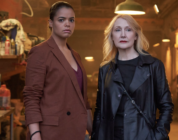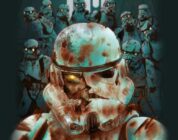The zombie genre has proven wildly adaptable, transcending cultures and national borders. Plenty of efforts trade in action-horror mayhem, while others use a return of the (generally flesh-craving) undead as an inciting incident for grander social statements or inquiries pegged to societal breakdown. In terms of explorative value, though, the rush and any ongoing cataloging of grief tends to get the short end of the stick. Deaths almost always mean something in zombie films, but there are usually other exigencies at play.
Norwegian film Handling The Undead is an outlier in this regard. It aims, in telling the story of several families thrown into chaos when their loved ones suddenly reanimate, to unpack the nature of sorrow and loss, and then being pulled suddenly back into anguish in a confusingly reconstituted form. It’s a worthy idea, in theory. The end result, however, is a bit muddled—a would-be elegy that offers neither conventional catharsis nor quite enough mesmeric, meditative insight to justify its somberness.
The directorial debut of Thea Hvistendahl, Handling The Undead consists of three discrete narrative strands, set in present-day Oslo. It’s over eight-and-a-half minutes until the first words in the film are spoken, but in that time viewers have absorbed an ocean of distance between Anna (Renate Reinsve) and her father Mahler (Bjørn Sundquist), who lives nearby. The root cause of this icy silence? Anna’s son Elias (Dennis Østby Ruud), recently deceased.
After a curious and unexplained power surge sends bursts of screeching static through radio waves, strange times arrive. Eva (Bahar Pars) dies in a car accident, but then comes back to life, leaving her boyfriend David (Anders Danielsen Lie) unsure of how to explain things to their children Kian (Kian Hansen) and Flora (Inesa Dauksta). Meanwhile, well-heeled Tora (Bente Børsum) is stunned to wake up and find her just-buried partner of many years, Elisabet (Olga Damani), back in their home, standing next to an open refrigerator. Mahler, too, digs up Elias.
None of these undead individuals can speak, and of course there are no external authority figures to explain or offer meaningful guidance on their conditions. This leaves the affected parties to grapple with how to proceed, as well as the consequences of their decisions.
Pacing, admittedly rather subjective, is a difficult issue to critically parse without sounding like a hopeless grump. But almost all cinephiles have had the experience of becoming distracted and having their mind wander during a 90-minute movie, while being held in rapturous attention by a three-hour film. When scenes feel intentional, their deliberateness conveying an abundance of information, their length doesn’t matter.
Unfortunately, that’s not always the case in Handling The Undead, which is ponderous and feels, in its bones, like it would be better suited to a different medium. Perhaps that’s not surprising, given that the film is based on a 2005 Swedish novel of the same name, co-adapted for the screen by Hvistendahl and author John Ajvide Lindqvist, the latter of whom also penned the superb Let The Right One In.
This translation to the screen has many elements that “work,” at least on an individual level. Composer Peter Raeburn’s score, which picked up a special jury award at the Sundance Film Festival when the movie made its debut there earlier this year, trades in thin ribbons of surging dread that subconsciously mirror the movie’s triggering electromagnetic pulse.
Cinematographer Pål Ulvik Rokseth works in grays and generally dim lighting, while also incorporating some occasional God’s-eye views and expansive exteriors that communicate a shared sense of unseen oppression and suffering, both symbolic and actual.
The film’s acting is naturalistic and subdued, matching in hand-in-glove fashion the film’s orchestrated tone. Reinsve in particular excels at conjuring a character more deeply imagined than what might appear on the surface; when she discovers Elias alive, she convincingly sells the highly reactive yet wildly inward nature of Anna’s response.
The problem, though, is that there’s no ecstatic truth here, to borrow a phrase from Werner Herzog—no higher state of sublimity that unlocks powerful observations, or even lasting feelings, about the essence and weight of grief. The nature of these characters grappling with irrevocably changed loved ones—reaching for a normalcy that will never return, and then coping with wounds both reopened and new, figurative and literal—should lend itself to an engrossing portrait of churning emotional disorientation.
Instead, Handling The Undead merely, and heavily, leans into mood. It unfolds as a tastefully curated presentation of realities (some would say mundanities), its buttoned-up mode of expression trying to wrap up its story in a thin cloak of profundity.
It’s true that sometimes these moments, in piecemeal fashion, are effective. It’s quietly gripping when Elisabet sheds a tear after being groomed by Tora, or Mahler applies eyedrops to his reanimated grandson and then gently bathes him, as Elias gurgles and moans. Other times, though, scenes come across as risibly ill-conceived, as when a shellshocked David returns home and tells Flora of her stepmother, “She died on the operating table, but then woke up. Get some sleep.” Most of the time, they land flatly, suffer from an obvious set-up, or both.
The cooking comparison for Handling The Undead would be a sauce that’s broken, its elements having separated. There’s a genuine sense of lived-in sadness here, but it isn’t enough to elevate the proceedings into something special or compelling. This is partly because the film steadfastly refuses to allow its characters to have any honest conversations about their feelings, but it also owes to a triptych structure that undercuts attempts at accumulated poignance. That construction works better on the printed page, but is an ill-suited match for a movie shaped much more by themes than plot or character.




